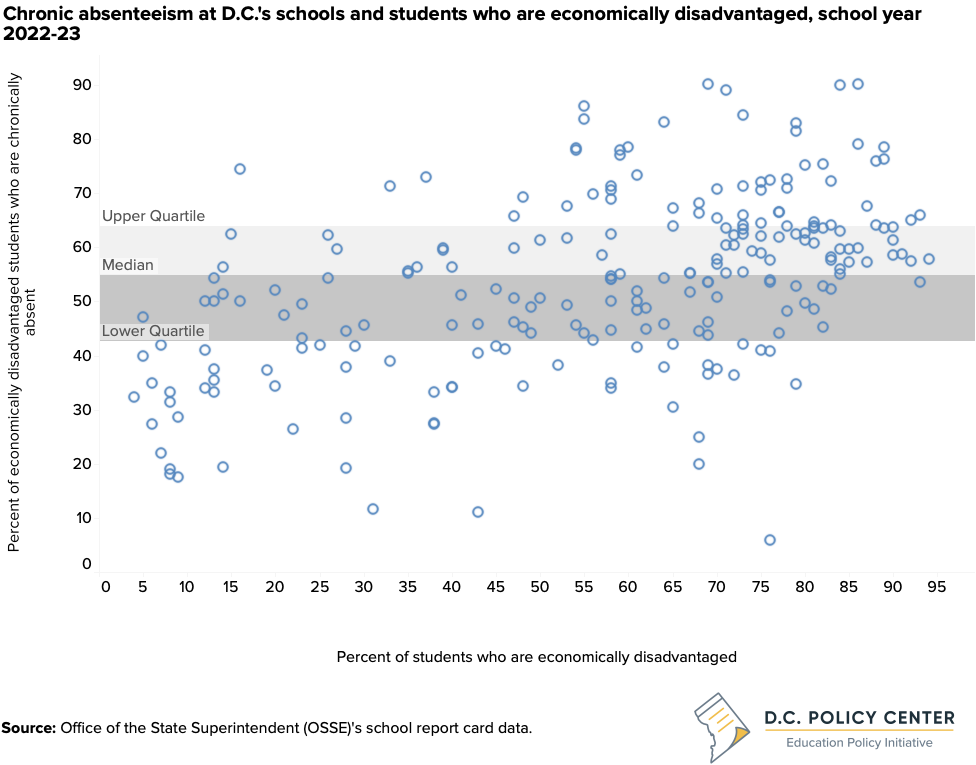
On Wednesday, June 26, 2024, Education Policy Initiative Director Chelsea Coffin testified before the D.C. Council Committee of the Whole at its attendance hearing. Her testimony focuses on how funding for absenteeism would be counterproductive, tracking student referrals should be done in a way that reduces the burden on schools, and connecting data reporting with more action is important. You can read her testimony below, or download a PDF copy.
On B25-0754, the Chronic Absenteeism and Truancy Reduction Amendment Act of 2024, D.C. Council should remove the suggestion of an additional funding category to the student funding formula with the weight of 0.1 specifically to address chronic absenteeism. Adding a weight to address chronic absenteeism would reward schools that serve similar student populations but have higher rates of chronic absenteeism at the school level. At the median school, for example, 55 percent of economically disadvantaged students are chronically absent, with about half of schools falling within 43 percent and 64 percent of students who are chronically absent. However, this additional funding for chronic absenteeism would disproportionately benefit those with the highest levels of chronic absenteeism at the top of the chart below and, counterintuitively, provide less resources to schools reducing chronic absenteeism while serving similar populations.1 Instead, if the District wants to invest additional resources to reduce chronic absenteeism, the Office of the State Superintendent of Education (OSSE) or the Deputy Mayor for Education (DME) could create a grant program to fund promising practices.

Finally, this would be incredibly difficult to implement because chronic absenteeism data are typically not available until December of the following school year, meaning that any budgets would rely on outdated chronic absenteeism that lags by 2 years and does not reflect the current situation. Instead, this bill could provide more funding to at-risk students or high school students through the formula, understanding that these are the students who are more likely to be chronically absent on average (in school year 2021-22, 66 percent of at-risk students were chronically absent compared to 29 percent of not at-risk students; 60 percent of high school students were chronically absent in school year 2022-23 compared to 44 percent of all students).2
Second, B25-0758, The Showing Up for Students Amendment Act of 2024, and B25-0791, Utilizing Partnerships and Local inventions for Truancy and Safety (UPLIFT) Amendment Act of 2024, both mention the Department of Human Services (DHS) as a new referral partner for unexcused absences. However, adding a new agency without specifically thinking through how reporting protocols would work will increase the bureaucratic burden on schools. It can even be challenging to track and move students through the current and simpler referral process. The addition of a new government agency as a less punitive first stop as partner could be beneficial, but it adds a layer that schools will have to track and a new system to navigate. There is a need to streamline this process for schools so that students do not get lost in the shuffle.
Third, B25-0740, Truancy Reduction for Student Success Act of 2024, requires monthly reporting on chronic absenteeism by school. Diligent reporting on absenteeism during the year is a good thing, but it should be done in a way that creates minimal burdens on schools and it should have some actions attached to it—perhaps for OSSE to look into schools that are having positive results compared to the same time the previous year to share out in real time what they believe is behind the success. It could also build on OSSE’s attendance reporting every few months this school year, which reported chronic absenteeism as of November this school year.3
More work is needed to think through the implications of these bills for schools and ultimately improving attendance.
Endnotes
- In addition, adding a weight based on outcomes would be inconsistent with the principles of D.C.’s Uniform Per Student Funding Formula (UPSFF). All other weights are based on student characteristics such as grade or student’s eligibility for certain public benefits, for example.
- Office of the State Superintendent of Education (OSSE). 2024. OSSE Data and Reports (School Report Card and Attendance Report data). OSSE. Retrieved from https://osse.dc.gov/page/data-and-reports-0
- Coffin, C. 2024. “Chart of the week: Majority of schools in D.C. on track to improve chronic absenteeism as of fall 2023.” D.C. Policy Center. Retrieved from: https://www.dcpolicycenter.org/publications/chart-of-the-week-schools-on-track-to-improve-chronic-absenteeism/
